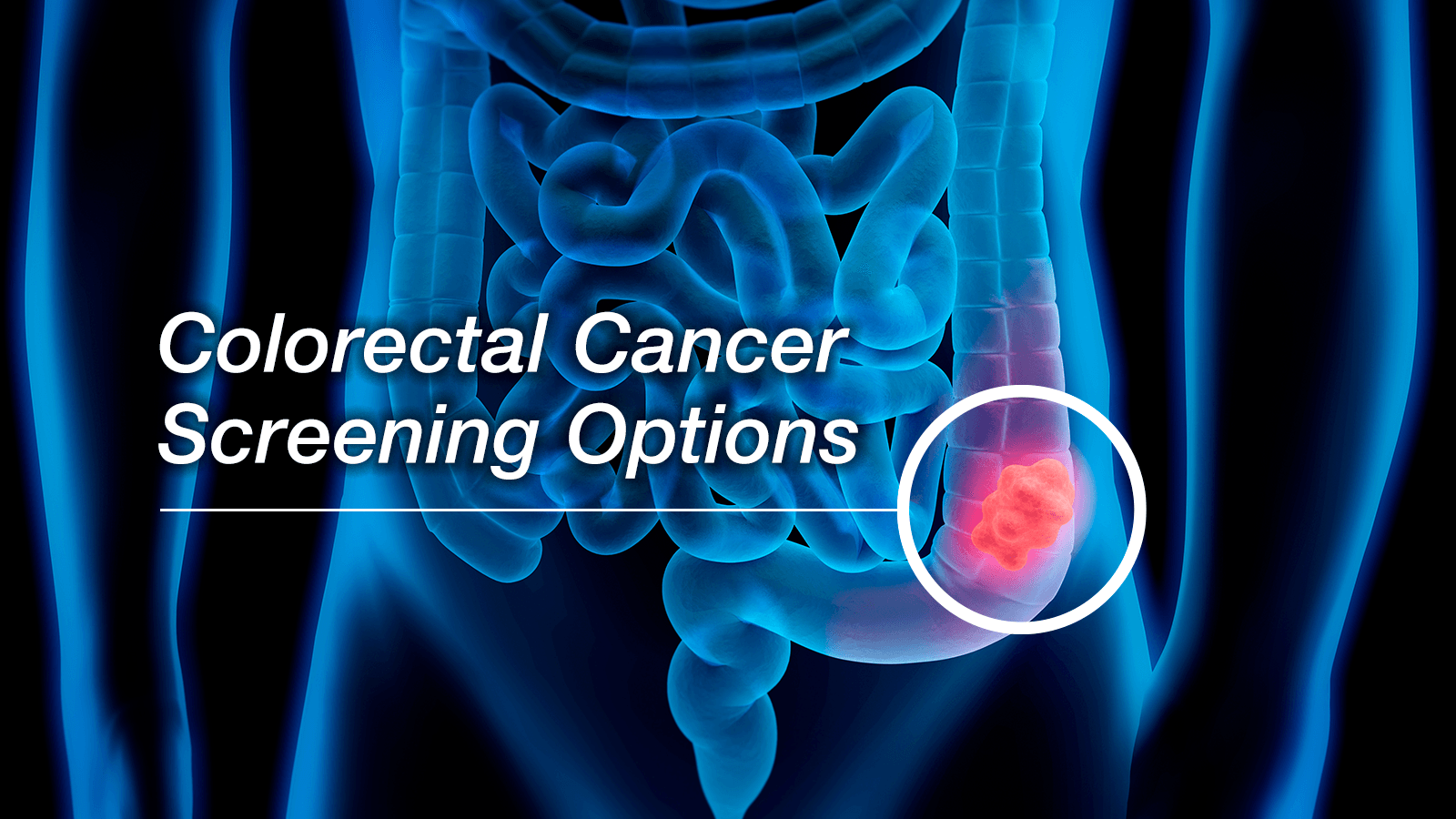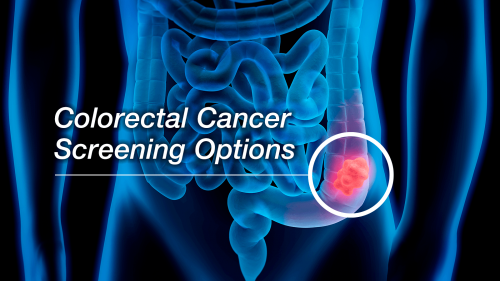
Image

The evidence is clear – screening for colorectal cancer may save your life. Today, more and more people are choosing colorectal cancer screening. As a result, there is a steady decline in the number of older people getting and dying from colorectal cancer. Lower rates of smoking among Americans have also contributed to the decline in the past several years.
Colorectal cancer usually starts from polyps or other precancerous growths in the rectum or the colon (large intestine). The only way to find a polyp, precancerous growth, or colorectal cancer is to do a screening test or procedure.
The benefits of screening are so great that doctors recommend most people start colorectal cancer screening by age 50. Some people who are at higher risk may need to start screening before age 50. And some organizations, such as the American Cancer Society, recommend screening begin no later than 45.
Your Colorectal Cancer Screening Choices
Different screening approaches for colorectal cancer have different pros and cons.
- Frequency – Some types of screening are better at finding cancer. The gold standard for screening, a colonoscopy, only needs to be done once every 10 years for people at average risk if no precancerous changes are found.
- Location – Some test samples can be collected in the comfort and privacy of your own home. Other types of screening must be done in a doctor’s office or hospital.
- Sedation – Some screening procedures require anesthesia (pain medicine) and sedation. Your doctor will talk with you about your health history and preferences to customize the type of pain medicine and sedation you will need during the procedure.
- Colon cleansing – Some screenings require you to take prescription medicine beforehand to clean out all of the stool in your colon and rectum. This cleansing process, sometimes called “bowel prep,” can be uncomfortable and usually means having diarrhea for several hours before the procedure.
- Risks and benefits – Procedures that require sedation and involve a doctor looking at the inside of the colon and rectum have more serious risks. However, the chance of harm during a colorectal cancer screening is small, and the chance of saving your life is high.
- Follow up procedures – Most tests require you to get a colonoscopy, the gold standard for screening, if the first test result is not normal.
Many people find that the temporary discomfort of invasive screening procedure is worth long-term peace-of-mind. Talk to your doctor to figure out which type of screening is best for you.
Colorectal Cancer Screening: FDA-Reviewed and Approved or Cleared
The U.S. Food and Drug Administration reviews and clears or approves colorectal cancer tests, prescription medicines, and medical devices used during colorectal cancer screening.
Today there are 2 types of screening recommended for colorectal cancer:
- Stool (poop) sample tests
- Visual screening procedures such as colonoscopy (doctors use medical devices to look at the inside of your colon and rectum)
Other types of screening can be done, but they are usually recommended only when a stool sample test or visual screening procedure cannot be done. There is an FDA-approved blood test for people who choose not to take a stool sample test or have their doctor do a visual screening procedure.
Stool Sample Tests
Your doctor can prescribe an at-home stool test. You use the kit to test your stool for blood or DNA (or both) from colorectal cancer. Some types of stool sample tests should be done once a year. Other types should be done at least every 3 years, or more often if your doctor recommends.
If the test shows blood or possible DNA from cancer or a precancerous polyp, your doctor will order a colonoscopy or other type of visual screening to get more information.
Visual Screening
Visual screening is when a specially trained doctor uses a medical device to look inside of your colon and rectum for polyps or other abnormal growths that may be cancer or precancerous. These procedures usually require colon cleansing or bowel prep the day before. Some types of visual screening require sedation or general anesthesia. Visual screening must be done in a doctor’s office or hospital.
- Colonoscopy — A doctor uses a thin tube with a light, camera, and surgical tools to look inside the rectum and colon for growths, other abnormal tissue, or cancer. If the doctor sees any precancerous polyps or abnormal growths, he or she can remove the tissue during the procedure. Removing polyps during a colonoscopy usually prevents them from turning into cancer later.
- Flexible Sigmoidoscopy — A doctor uses a thin tube with a light, camera, and surgical tools to look inside the rectum and lower third of the colon for growths, other abnormal areas tissues, or cancer. If the doctor sees any precancerous polyps or abnormal growths, he or she can remove the tissue during the procedure. Removing polyps during a sigmoidoscopy usually prevents them from turning into cancer later.
- CT Colonography (or “Virtual Colonoscopy”) — A series of X-rays, similar to a CT scan, of the colon. The colon will be gently and temporarily inflated with air through a thin tube tip placed in the rectum.
Dr. Jacqueline Cunkelman, a Medical Officer in the Office of Product Evaluation and Quality in the FDA Center for Devices and Radiological Health says, “The science is clear—colonoscopy saves lives. Talk to your doctor. Share your fears or concerns about colon cancer screening. Together you can decide which type of screening is best for you.”
Some Minority Groups Are at Higher Risk
Colorectal cancer is more common among certain racial minority groups. For all groups, men are significantly more likely to get and die from colorectal cancer. Compared to non-Hispanic white men and women, Black men and women are at the highest risk of getting and dying from colorectal cancer. American Indian and Alaska Native people are also at higher risk of dying from colorectal cancer.
Racial and ethnic minority communities have often faced greater barriers to disease prevention, detection, and treatment for many illnesses — and unfortunately, that includes colorectal cancer, said RADM Richardae Araojo, Associate Commissioner for Minority Health and Director of the FDA’s Office of Minority Health and Health Equity. These barriers can include access to health care, access to healthy foods, health insurance status, and transportation just to name a few. “Early detection, referral, and treatment can significantly reduce disparities in deaths from colorectal cancer.”
Colorectal Cancer Rates Are Up Among Adults Under 50
While colorectal cancer rates are falling among older people, rates are going up for adults in their 40s and younger. Cancer of any type is rare in people under 50, but the numbers show that colorectal cancer is no longer just a disease of older adults.
Researchers aren’t sure why rates are going up in young adults but encourage people of all ages to be aware of significant changes in their bowel habits and stool (poop). Blood in the stool and other stomach problems such as gas, constipation, pain, vomiting, unexplained weight loss or bloating can be a sign of colorectal cancer. But these symptoms can be caused by many different health problems, so it’s best to talk to your doctor or nurse.
How Can I Lower My Risk of Colorectal Cancer?
In addition to getting screened for colorectal cancer, all of us can lower our risk of developing colorectal cancer with healthy behaviors. Proven behaviors to prevent colorectal cancer include:
- Physical activity – Studies show that getting regular exercise can lower your risk of colorectal cancer by 24%. For substantial health benefits, experts recommend doing 30 to 60 minutes of exercise most days of the week. Exercise can include everyday activities like walking a dog, doing chores around the house, or using the stairs.
- Lowering alcohol use – Studies show that drinking 3 or more alcoholic drinks per day increases your risk of colorectal cancer by 41%.
- Not smoking – Studies show that people who smoke have an 18% higher risk of colorectal cancer.
- Keeping a healthy weight – Studies show that women with obesity have a 45% higher risk of getting and dying from colorectal cancer.
If you are 50 or older you might want to talk to your doctor about whether you have certain risk factors for heart disease or colorectal cancer, and if you should take low-dose aspirin to help prevent these conditions. Although aspirin is available over-the-counter, like any medicine, there are both risks and benefits to taking it. Talk to your doctor before taking aspirin for colorectal cancer prevention or heart disease prevention.
For more information
For more information about preventing or screening for colorectal cancer go to the National Cancer Institute’s (NCI’s) website or call NCI’s Cancer Information Service (CIS) at 1-800-4-CANCER (1-800-422-6237).
Source: FDA
This webpage is made available by Online Press Release, Micro News







